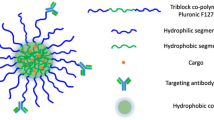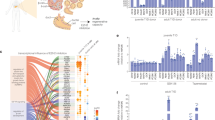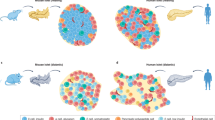Abstract
Type 1 diabetes (T1D) is a chronic autoimmune disorder which affects the insulin-producing beta cells in the pancreas. A variety of strategies, namely, insulin replacement therapy, engineered vaccines, immunomodulators, etc., have been explored to correct this condition. Recent studies have attributed the development of T1D to the anomalous expression of microRNAs in the pancreatic islets. Here, we describe the protocol for the development of a theranostic approach to modify the expression of aberrant miRNAs. The MRI-based nanodrug consists of superparamagnetic iron oxide nanoparticles conjugated to microRNA-targeting oligonucleotides that can promote proliferation of pancreatic beta cells in a mouse model of T1D. This theranostic approach can successfully serve as a potential therapeutic approach for the targeted treatment of T1D with minimal side effects.
Access this chapter
Tax calculation will be finalised at checkout
Purchases are for personal use only
Similar content being viewed by others
References
Massaro S, Lorenzoni G (2021) Nanomedicine: a socio-technical system. Technol Forecast Soc Chang 173:121066. https://doi.org/10.1016/j.techfore.2021.121066
Ray S, Li Z, Hsu C-H, Hwang L-P, Lin Y-C, Chou P-T, Lin Y-Y (2018) Dendrimer- and copolymer-based nanoparticles for magnetic resonance cancer theranostics. Theranostics 8(22):6322–6349. https://doi.org/10.7150/thno.27828
Panwar N, Soehartono AM, Chan KK, Zeng S, Xu G, Qu J, Coquet P, Yong K-T, Chen X (2019) Nanocarbons for biology and medicine: sensing, imaging, and drug delivery. Chem Rev 119(16):9559–9656. https://doi.org/10.1021/acs.chemrev.9b00099
Bose RJC, Lee S-H, Park H (2016) Biofunctionalized nanoparticles: an emerging drug delivery platform for various disease treatments. Drug Discov Today 21(8):1303–1312. https://doi.org/10.1016/j.drudis.2016.06.005
Moore C, Jokerst JV (2019) Strategies for image-guided therapy, surgery, and drug delivery using photoacoustic imaging. Theranostics 9(6):1550–1571. https://doi.org/10.7150/thno.32362
McClements DJ (2018) Encapsulation, protection, and delivery of bioactive proteins and peptides using nanoparticle and microparticle systems: a review. Adv Colloid Interf Sci 253:1–22. https://doi.org/10.1016/j.cis.2018.02.002
Gu J, Al-Bayati K, Ho EA (2017) Development of antibody-modified chitosan nanoparticles for the targeted delivery of siRNA across the blood-brain barrier as a strategy for inhibiting HIV replication in astrocytes. Drug Deliv Transl Res 7(4):497–506. https://doi.org/10.1007/s13346-017-0368-5
Yuan P, Mao X, Wu X, Liew SS, Li L, Yao SQ (2019) Mitochondria-targeting, intracellular delivery of native proteins using biodegradable silica nanoparticles. Angew Chem Int Ed 58(23):7657–7661. https://doi.org/10.1002/anie.201901699
Man F, Lammers T, de Rosales TM (2018) Imaging nanomedicine-based drug delivery: a review of clinical studies. Mol Imaging Biol 20(5):683–695. https://doi.org/10.1007/s11307-018-1255-2
Pérez-Medina C, Teunissen AJP, Kluza E, Mulder WJM, van der Meel R (2020) Nuclear imaging approaches facilitating nanomedicine translation. Adv Drug Deliv Rev 154–155:123–141. https://doi.org/10.1016/j.addr.2020.07.017
Murakami T, Fujimoto H, Inagaki N (2021) Non-invasive Beta-cell Imaging: Visualization, Quantification, and Beyond. Front Endocrinol 12(791). https://doi.org/10.3389/fendo.2021.714348
DiMeglio LA, Evans-Molina C, Oram RA (2018) Type 1 diabetes. Lancet 391(10138):2449–2462. https://doi.org/10.1016/S0140-6736(18)31320-5
Katsarou A, Gudbjörnsdottir S, Rawshani A, Dabelea D, Bonifacio E, Anderson BJ, Jacobsen LM, Schatz DA, Lernmark Å (2017) Type 1 diabetes mellitus. Nature Rev Dis Primers 3(1):17016. https://doi.org/10.1038/nrdp.2017.16
Vetere A, Choudhary A, Burns SM, Wagner BK (2014) Targeting the pancreatic β-cell to treat diabetes. Nat Rev Drug Discov 13(4):278–289. https://doi.org/10.1038/nrd4231
Assmann TS, Recamonde-Mendoza M, De Souza BM, Crispim D (2017) MicroRNA expression profiles and type 1 diabetes mellitus: systematic review and bioinformatic analysis. Endocrine Connect 6(8):773–790. https://doi.org/10.1530/ec-17-0248
Hanna J, Hossain GS, Kocerha J (2019) The potential for microRNA therapeutics and clinical research. Front Genet 10(478). https://doi.org/10.3389/fgene.2019.00478
Lu TX, Rothenberg ME (2018) MicroRNA. J Allergy Clin Immunol 141(4):1202–1207. https://doi.org/10.1016/j.jaci.2017.08.034
Kozomara A, Birgaoanu M, Griffiths-Jones S (2018) miRBase: from microRNA sequences to function. Nucleic Acids Res 47(D1):D155–D162. https://doi.org/10.1093/nar/gky1141
Belgardt B-F, Ahmed K, Spranger M, Latreille M, Denzler R, Kondratiuk N, von Meyenn F, Villena FN, Herrmanns K, Bosco D, Kerr-Conte J, Pattou F, Rülicke T, Stoffel M (2015) The microRNA-200 family regulates pancreatic beta cell survival in type 2 diabetes. Nat Med 21(6):619–627. https://doi.org/10.1038/nm.3862
Osmai M, Osmai Y, Bang-Berthelsen CH, Pallesen EMH, Vestergaard AL, Novotny GW, Pociot F, Mandrup-Poulsen T (2016) MicroRNAs as regulators of beta-cell function and dysfunction. Diabetes Metab Res Rev 32(4):334–349. https://doi.org/10.1002/dmrr.2719
Özcan S (2014) Minireview: microRNA function in pancreatic β cells. Mol Endocrinol 28(12):1922–1933. https://doi.org/10.1210/me.2014-1306
Song I, Roels S, Martens GA, Bouwens L (2017) Circulating microRNA-375 as biomarker of pancreatic beta cell death and protection of beta cell mass by cytoprotective compounds. PLoS ONE 12(10):e0186480. https://doi.org/10.1371/journal.pone.0186480
Ofori JK, Salunkhe VA, Bagge A, Vishnu N, Nagao M, Mulder H, Wollheim CB, Eliasson L, Esguerra JLS (2017) Elevated miR-130a/miR130b/miR-152 expression reduces intracellular ATP levels in the pancreatic beta cell. Sci Rep 7(1):44986. https://doi.org/10.1038/srep44986
Ruan D, Liu Y, Wang X, Yang D, Sun Y (2019) miR-149-5p protects against high glucose-induced pancreatic beta cell apoptosis via targeting the BH3-only protein BIM. Exp Mol Pathol 110:104279. https://doi.org/10.1016/j.yexmp.2019.104279
Aghaei M, Khodadadian A, Elham K-N, Nazari M, Babakhanzadeh E (2020) Major miRNA involved in insulin secretion and production in beta-cells. Int J Gen Med 13:89–97. https://doi.org/10.2147/IJGM.S249011
Dwan BF, Moore A, Wang P (2019) Nucleic acid-based theranostics in type 1 diabetes. Transl Res 214:50–61. https://doi.org/10.1016/j.trsl.2019.08.006
Xu L, Li Y, Yin L, Qi Y, Sun H, Sun P, Xu M, Tang Z, Peng J (2018) miR-125a-5p ameliorates hepatic glycolipid metabolism disorder in type 2 diabetes mellitus through targeting of STAT3. Theranostics 8(20):5593–5609. https://doi.org/10.7150/thno.27425
Knerr L, Prakash TP, Lee R, Drury Iii WJ, Nikan M, Fu W, Pirie E, Maria LD, Valeur E, Hayen A, Ölwegård-Halvarsson M, Broddefalk J, Ämmälä C, Østergaard ME, Meuller J, Sundström L, Andersson P, Janzén D, Jansson-Löfmark R, Seth PP, Andersson S (2021) Glucagon like peptide 1 receptor agonists for targeted delivery of antisense oligonucleotides to pancreatic beta cell. J Am Chem Soc 143(9):3416–3429. https://doi.org/10.1021/jacs.0c12043
Wang P, Liu Q, Zhao H, Bishop JO, Zhou G, Olson LK, Moore A (2020) miR-216a-targeting theranostic nanoparticles promote proliferation of insulin-secreting cells in type 1 diabetes animal model. Sci Rep 10(1):5302. https://doi.org/10.1038/s41598-020-62269-4
Medarova Z, Evgenov NV, Dai G, Bonner-Weir S, Moore A (2006) In vivo multimodal imaging of transplanted pancreatic islets. Nat Protoc 1(1):429–435. https://doi.org/10.1038/nprot.2006.63
Yoo B, Kavishwar A, Ross A, Wang P, Tabassum DP, Polyak K, Barteneva N, Petkova V, Pantazopoulos P, Tena A, Moore A, Medarova Z (2015) Combining miR-10b–targeted nanotherapy with low-dose doxorubicin elicits durable regressions of metastatic breast cancer. Cancer Res 75(20):4407–4415. https://doi.org/10.1158/0008-5472.can-15-0888
Yoo B, Kavishwar A, Wang P, Ross A, Pantazopoulos P, Dudley M, Moore A, Medarova Z (2017) Therapy targeted to the metastatic niche is effective in a model of stage IV breast cancer. Sci Rep 7(1):45060. https://doi.org/10.1038/srep45060
Kumar P, Nagarajan A, Uchil PD (2018) Analysis of cell viability by the MTT assay. Cold Spring Harb Protoc 2018(6):pdb.prot095505. https://doi.org/10.1101/pdb.prot095505
Wang P, Yigit MV, Medarova Z, Wei L, Dai G, Schuetz C, Moore A (2011) Combined small interfering RNA therapy and in vivo magnetic resonance imaging in islet transplantation. Diabetes 60(2):565–571. https://doi.org/10.2337/db10-1400
Wang P, Yigit MV, Ran C, Ross A, Wei L, Dai G, Medarova Z, Moore A (2012) A theranostic small interfering RNA nanoprobe protects pancreatic islet grafts from adoptively transferred immune rejection. Diabetes 61(12):3247–3254. https://doi.org/10.2337/db12-0441
Jiang X, Shan A, Su Y, Cheng Y, Gu W, Wang W, Ning G, Cao Y (2015) miR-144/451 promote cell proliferation via targeting PTEN/AKT pathway in insulinomas. Endocrinology 156(7):2429–2439. https://doi.org/10.1210/en.2014-1966
Deeds MC, Anderson JM, Armstrong AS, Gastineau DA, Hiddinga HJ, Jahangir A, Eberhardt NL, Kudva YC (2011) Single dose streptozotocin-induced diabetes: considerations for study design in islet transplantation models. Lab Anim 45(3):131–140. https://doi.org/10.1258/la.2010.010090
Wang P, Ross A, Yoo B, Yang J, Farrar C, Ran C, Pantazopoulos P, Medarova Z, Moore A (2017) Magnetic resonance imaging of intra-pancreatic ductal nanoparticle delivery to islet cells. Diabetes Metab Res Rev 33(5):e2881. https://doi.org/10.1002/dmrr.2881
Author information
Authors and Affiliations
Corresponding authors
Editor information
Editors and Affiliations
Rights and permissions
Copyright information
© 2023 The Author(s), under exclusive license to Springer Science+Business Media, LLC, part of Springer Nature
About this protocol
Cite this protocol
Nigam, S., Moore, A., Wang, P. (2023). miRNA Theranostic Nanoparticles Promote Pancreatic Beta Cell Proliferation in Type 1 Diabetes Model. In: Moore, A., Wang, P. (eds) Type-1 Diabetes. Methods in Molecular Biology, vol 2592. Humana, New York, NY. https://doi.org/10.1007/978-1-0716-2807-2_15
Download citation
DOI: https://doi.org/10.1007/978-1-0716-2807-2_15
Published:
Publisher Name: Humana, New York, NY
Print ISBN: 978-1-0716-2806-5
Online ISBN: 978-1-0716-2807-2
eBook Packages: Springer Protocols




